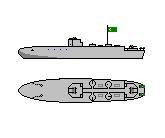[size=3]Motor Gunboats[/size]
MGB-1 Type
India had a tough time dealing with the Italian-built MAS boats operated by Filipino revolutionaries in that recent event. India's own MTBs lacked the armament necessary to win a fight at equal numbers, and lost a few of their number during skirmishes. Using a destroyer to hunt down MAS boats was considered risky, given India's loss of the Thimphu to MAS torpedos during the Dagupan landings (and the loss of the cruiser Delhi to Danish MTBS a few years earlier).
A possible answer fell into the Indians' lap late in the Revolution, when a Red MAS was captured during a raid (see ~Q2 1929 news). Officially reported sunk, the MAS was quietly returned to India for repairs and evaluation at Port Blair.
After a year and a half of studies, the Indians decided to build a prototype version of their own for evaluation in a dedicated anti-MTB/MAS role. Thus the 10 cm gun on the original is replaced by a twin 35 mm gun, a second such weapon replaces the torpedos aft, and two 15 mm machine guns on pintle mounts are located amidships. Four depth charges are embarked to assist in escape from destroyers, and are controlled from the aft 35 mm station. A single 75 mm mortar, fixed to fire forward, is also installed for firing flares.
The single boat was built in secrecy in Q3 1931 and deployed to Sittwe, for trials with various Indian light craft. Three additional units were built in 1932 and are working up, with an expectation that the group will deploy to the Persian Gulf in early 1933. The original MAS will likely be turned over to the Philippines following its "unexpected discovery in a remote lagoon in the Phillipines".
(India will no doubt encounter the same seakeeping issues identified by Italy (in the Italian encyclopedia enty), but that will only come with time. And go easy on the drawing - I was working off the model photo in the Italian encyclopedia so was guessing at dimensions.)

Forward pits: 15 mm HMG each side
Aft pits: signal mast to starboard, forward firing mortar to port.
Specifications
Design Date: 1931
Units: MGB-1 (1931), MGB-2, -3, -4 (1932)
Displacement: 75 tons
Armament: 2x2 35mm, 2x1 15 mm, 1x75 mm mortar, 2x2 DC
Speed: 35 knots (newer engine offset by imperfect reverse-engineering of the hull form)

